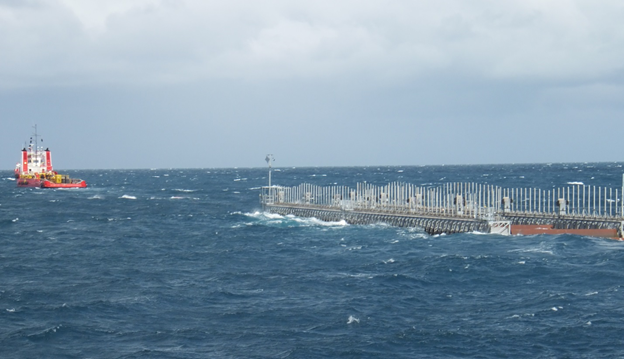Description
The Wave Rider™ is an offshore wave energy converter technology that converts the kinetic energy of the ocean into mechanical energy. The Wave Rider™ is made up of an open steel truss with numerous buoyancy pontoons that keeps the structure afloat. Along the length of the structure, a series of below surface buoys are fitted that move up and down as a wave passes.
This movement causes the rotation of an axle on top of the structure that is connected via a chain system, which in turn drives various generators that convert the mechanical energy into electrical energy.

Wave Rider™ energy converter on the sea trial.
Location
The Wave Rider energy converter was intended to be deployed off the west coast of South Australia and floated about 400 meters off Elliston on Eyre Peninsula and at 28m depth.
Licensing Information
The project received its development approval by the development assessment commission in South Australia as well as a seabed lease from the South Australian government in late 2008. The Australian Commonwealth through the Department of Environment, Water, Heritage and the Arts (DEWHA) has approved the project after a detailed assessment of potential environmental impacts in 2011. The local council was also involved in the process. The project received various approvals from DEWHA prior the extensive sea trial.
Project Progress
The Wave Rider™ was awarded a High Commendation in Engineering Projects Steel Design by Australian Steel Institute in year 2012.
The Wave Rider™ has completed an extensive sea trial in South Australian waters as part of a testing phase designed to validate the concept of the technology. The sea trial has provided sufficient data and it has confirmed the performance of the Wave Rider™ exceeded its anticipated outcome. Therefore more testing with this pilot near Elliston will no longer be a requirement.
Wave Rider Energy is currently focused its investment on working on a new pre-commercial plant with the end use of delivering energy for a community as its primary objective.
Key Environmental Issues
Environmental impacts such as coastal processes, water quality and visual impacts were assessed during the selection of the development location. The interaction of the pilot plant on birds, seals, Australian Sea-lion, Southern and Pygmy Right Whales were monitored during the pilot study. A marine surveyor was employed to observe the interactions of the Wave Rider with the surrounding environment throughout the journey of the sea trial. The marine surveyor reported that there is no sign of any interaction between the structure and the animals at all.
Environmental Webpage: http://www.waveriderenergy.com.au/Environment.html
Environmental Monitoring: Wave Rider Wave Energy Pilot Plant
| Phase | Stressor & Receptor | Design and Methods | Results |
|---|---|---|---|
| Baseline | Noise Marine Mammals |
To study the relationship between the noise and the sensitivity hearing ranges of the animals Local vertebrates recording via observation | Completed No sign of interaction |
| Baseline | EMF, Habitat Change, Noise Fish, Human Dimensions, Fisheries |
To study the interaction of the Wave Rider and the commercial fishery operations Local fish recording via observation | Completed No sign of interaction |
| Baseline | Habitat Change Birds |
To confirm quantitatively that there are no adverse effects to the bird populations resulting from the Wave Rider Local bird recording via observation | Completed No sign of interaction |
| Baseline | Habitat Change Physical Environment |
To study the effect of mooring fixtures to the marine sea grasses N/A | Completed Non-invasive |
| Baseline | Habitat Change Physical Environment |
To identify the risk associated with physical damage to marine flora N/A | Completed Non-invasive |
